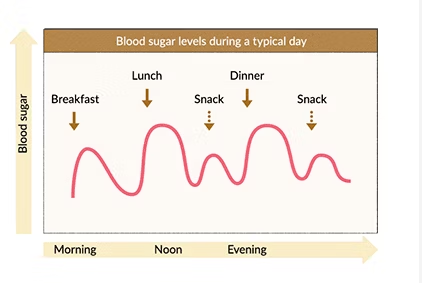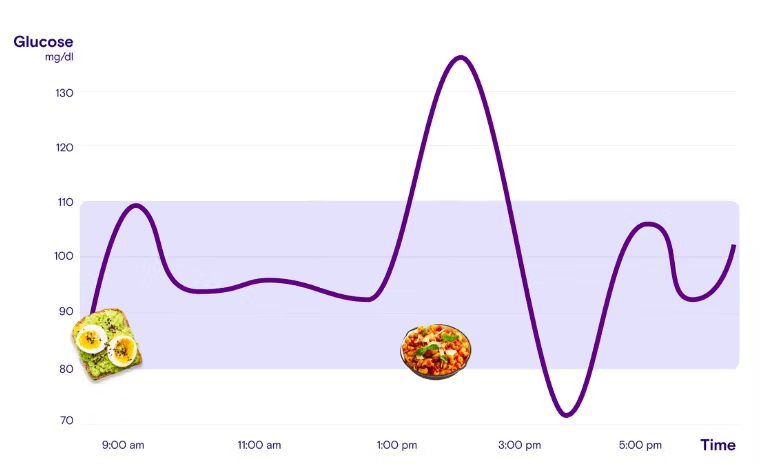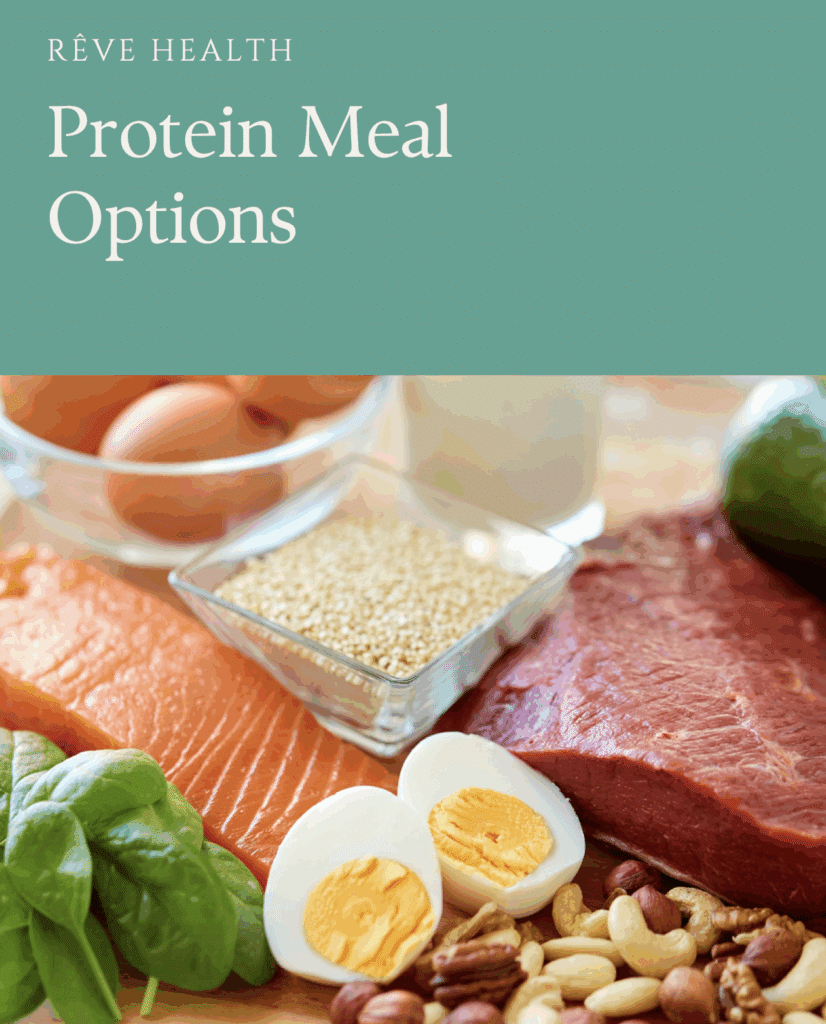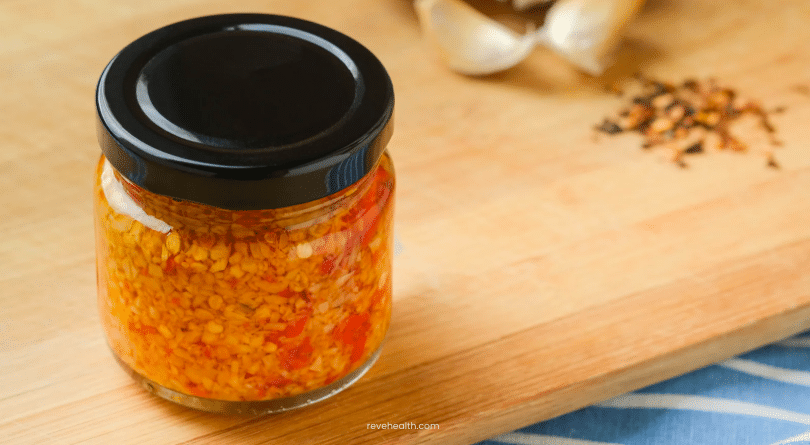How to Balance Your Blood Sugar

Balance Your Blood Sugar For Better Health
Balancing your blood sugar truly is one of the best things you can do for your overall health.
Some of the many benefits include:
Improve muscle health and growth
Regulate cortisol (the stress response)
Improve your metabolism and thyroid function
Create stable energy
Limit sugar cravings
Help with weight loss
In this blog we’ll show you practical tips to balance your blood sugar!

Blood Sugar Fluctuates Through The Day
When we eat, our bodies break down mostly carbohydrates (think grains, breads, and pastas but also fiber such as fruits and vegetables) and smaller amounts of protein into glucose, or blood sugar. Fat doesn’t impact our blood sugar levels.
When our blood sugar levels rise, the pancreas is signaled to release the hormone insulin. In order for the glucose to leave our blood steam and be used for energy, it needs insulin to carry it into the cells.
Once the glucose is carried into our cells, our blood sugar levels go back to baseline. The rise and fall of blood sugar happens several times throughout the day and is a healthy body response.
After each meal blood sugar increases. The more carbohydrates with that meal, the larger the blood sugar increase (more on that later). Between each meal, blood sugar dips, signaling your body that it’s time to eat again.

When Things Go Wrong
The most common ways blood sugar becomes imbalanced include:
Not eating often enough
Eating too much at once
Not incorporating enough protein and/or fiber
High stress levels
Almost all blood sugar imbalances begin with having periods of high blood sugar levels followed by a period of low blood sugar before the body can normalize again. The goal is to have blood sugar rise and fall within normal fluctuations, as we saw on the previous lesson. An abnormal curve is when there is a dramatic rise followed by a dramatic fall in blood sugar.
Not Eating Enough
When we don’t eat enough, our bodies have to pull glucose from somewhere to keep our blood sugar stable. Even without eating, your body will find ways to maintain normal levels (it’s that important!)
Our bodies store excess glucose in our liver and muscles to be used between meals, in fasted states, or when we sleep. The muscles can be exceptionally effective at storing glucose when they are used frequently aka when we exercise.
When enough glucose has to be taken from the muscles, it results in a muscle breakdown. This further perpetuates the problem by decreasing the muscles’ ability to store extra glucose.
This shows up typically in people who are thin, have limited muscle mass, and have imbalanced hormones.

Eating Too Much
Often linked to not eating enough, eating too much at once can also lead to glucose issues. If we wait until we’re starving to eat, we often overeat to overcompensate for the hunger and low blood sugar we had going into the meal.
A typical example – the last meal you had was 6 hours ago. You’re starving and quickly eat your meal. After it’s done, you’re still craving something sweet. After eating a treat, you feel better.
Why is this? It takes about 15 minutes for your blood sugar to begin to rise after eating a meal. If you wait until you’re in a low blood sugar state to eat, your body will signal you to continue eating, even beyond when you’re full, until your blood sugar increases.
What raises our blood sugar the quickest? Sugar. Maybe that after-dinner dessert wasn’t a matter of willpower but rather your body’s way of telling you it needed food earlier!
Not Eating Enough Protein or Fiber
Protein and fiber help blunt our blood sugar responses. We need them both at each meal to contribute to a normal blood sugar curve.
Because protein digestion releases glucose much slower than carbohydrates, it blunts the absorption of carbohydrates in the bloodstream when eaten together. It also supports muscle health, where extra glucose can be stored.
Fiber, especially soluble fiber, helps blunt the blood sugar response by forming a gel-like substance when it is broken down in the stomach. This allows glucose to be release in the bloodstream slowly, keeping the blood sugar curve within normal range.
Examples of soluble fiber include oats, beans, nuts, avocados, apples, and most vegetables.
High Stress Levels
When our cortisol (stress response hormone) levels increase, it is signaling to the body it needs to prepare for danger. One of the ways the body responds is by increasing your blood sugar.
If you were in physical danger, you would likely need to be able to move. Our cells need energy for that. The body’s increased cortisol response doesn’t know the difference between an emotional or physical threat and it prepares for physical movement.
This means, even without eating, your blood sugar is rising when you’re in periods of increased stress.
Pre Diabetes
Most people think that diabetes happens when we eat too much sugar for too long. But is that true?
While sugar is often part of the problem, it is rarely the whole problem.
Most people know sugar and processed foods aren’t great for their health and yet many people have issues with creeping up blood sugar markers.
Far more often than not, insulin resistance (pre-diabetes) and diabetes occur after periods of having blood sugar spikes followed by blood sugar crashes. It is this rollercoaster over long periods of time that leads to insulin resistance, a period I like to call the pre-pre-diabetes.
The pre-pre-diabetes state can also include hormone imbalances, irregular cycles, anxiety, difficulty losing weight, thyroid issues, difficulty sleeping, increased hot flashes, and poor muscle growth.
If we learn how to structure our meals and improve the timing when we eat, we can get off the blood sugar rollercoaster.
Tips for Structuring Meals
Add Protein
Aim for at least 25-35 grams of high quality protein per meal. See the attached handout for protein recommendations with serving sizes.
Add Fiber
Aim for 1-2 cups of fiber per meal, mostly vegetables. This can include leafy greens, non-starchy vegetables like peppers and cucumbers, or mixing in starchy vegetables like sweet potatoes or squash.
Add Healthy Fat
Include a fat source with each meal. Use extra virgin olive oil in salad dressings, have half an avocado, sprinkle hemp seeds in your smoothies, have nut butter with fruit, or any other way you enjoy having fats.
Get Creative with Snacks
For snacks, try to combine two of the above categories – protein with fat, carbohydrates with protein, carbohydrates with fat, or any other combination. The most important factor to remember is including a protein or fat with a carbohydrate.
Know Your Tolerance Window
One of the most important factors in maintaining stable blood sugar is understanding your blood sugar tolerance window.
Everyone’s tolerance for how long they can go between meals without eating is different.
For some, especially with chronic health issues, 2 hours may be the window. For others with more stability in their health, it may be 4-5 hours.
How do you know you’re going too long between meals? You begin experiencing symptoms of low blood sugar. These include – anxiety, brain fog, fatigue, feeling cold, jitteriness, feeling faint, lack of focus, and increased hunger.
Finding your window:
Keep a food journal of what you eat in a day. Note the time you eat.
Make a note at any time you feel low blood sugar symptoms and what time they occurred.
At the end of the day, notice how many hours you went between each meals and if you had any symptoms of low blood sugar in that timeframe.
If you experienced symptoms of low blood sugar, have a meal or snack 30 minutes prior to when you experienced symptoms the previous day.
Note that meals that contain protein and fat will keep your blood sugar stable for longer. Meals with heavier carbohydrates (such as a bowl of pasta or cereal) will cause more rapid increases and declines in blood sugar and you may not be able to go as long between meals.
This is why it is so important to have protein, fat, and carbohydrates at each meal.
After you track and eat in your blood sugar window for several weeks, you may notice with the increased stability that you can go longer between meals and feel okay.
Usually there is a building tolerance window in the beginning of tracking where you need to be eating more frequently. This is normal.
What About Fasting?
Everyone is talking about intermittent fasting. Is it something you should be trying?
Our opinion is more often than not, no for women, especially menstruating women.
As mentioned in the previous lesson, women’s bodies crave stability. Adding in a stressor, like intermittent fasting, often does more harm to our metabolisms than good. In fact, 98% of the patient’s I’ve worked with in my private practice feel much better and lose more weight when they eat regularly.
In a perfect world, we recommend pre-menopausal women to consume breakfast with 25-35 grams of protein within an hour of waking.
“But I’m not hungry in the mornings..?”
Often not having a sense of hunger in the mornings is a stress response – our cortisol levels are too high, not that we aren’t actually hungry. Eating in the mornings may feel unnatural at first, but with time our metabolism will begin to come back online in the mornings. This is a good thing!
“I’m post-menopausal and heard intermittent fasting may help..?
Due to the discontinuation of the menstrual cycle, our hormones are less likely to fluctuate with stressors, such as fasting. While some post-menopausal women find intermittent fasting helpful, we still recommend going through the finding your blood sugar tolerance window process and extending your fasting time slowly from there. This will give your body time to adjust to increased fasting windows.
Any fasting attempts, pre- or post-menopausal, should be done after finding a period of stability in the body. Please consult your personal healthcare provider to see if fasting is right for you.
We have a webinar where we get into cold plunges, fasting, and other “biohacks” which you may enjoy.
The Gift of Balanced Blood Sugar
It may take some time to find your blood sugar tolerance window, play with the structure of your meals, and find balance in the body. Tune into your body and see how you feel after each meal. What worked? What didn’t? Do you need more protein to prevent blood sugar crashes? Do you go too long without eating between meals? Did you have a carbohydrate source to give your body energy
If after a few weeks things are still unclear, we recommend seeing a registered dietician to help you with an individual approach to blood sugar balancing.


